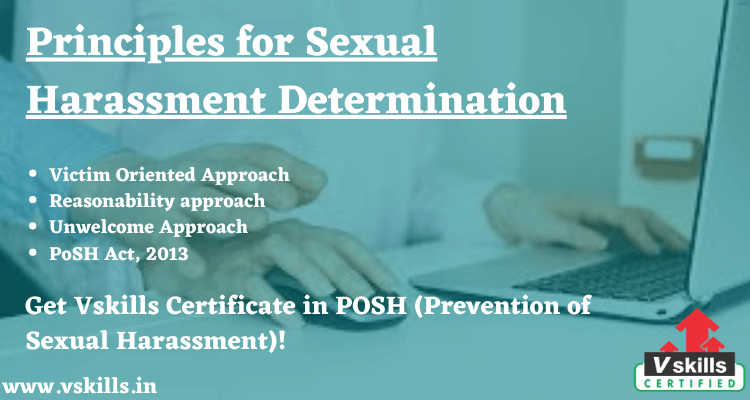
Let us discuss some Principles for Sexual Harassment Determination. In the determination of the cases of sexual harassment, one finds the applicability of the following approaches:
Victim Oriented Approach
Generally, in cases of reported sexual harassment, the authorities have a tendency to become biased in favor of the person sexually harassed. Such type of approach can be termed as a victim-centric approach. The situation is further complicated in cases of similarities of sexes between the victim and the deciding authorities.
Reasonability approach
In determining the cases of sexual harassment one has the option of looking at the instances of sexual harassment from the perspective of the victim or from the perspective of a reasonable individual. It is always difficult to look to the instance from the response of the victim on account of the sensitivity or selfishness in the behavior of the victim.
However, in the case of an adult person, an amount of care on his part attributable to a reasonable man in the circumstances may be expected and correspondingly the duty of care owed may be reduced. In the case of a child, having regard to its age, its mental development, and other attendant circumstances, not much care can be expected, and accordingly, the duty of care owed to it must then be of a higher standard. Thus reasonable behavior and reasonable person depends upon the facts and circumstances of a particular case. And for this, the age of the complaint, their sex, race or ethnicity, any disability they may have, the context in which the harassment occurred and the nature of the relationship between the parties will be taken into consideration.
Unwelcome Approach
The unwelcome approach seeks to analyze the behavior or conduct complained of from the point of view of the recipient. And unwelcome conduct is that conduct which is not solicited or invited by the person and the person regards the conduct as undesirable or offensive. The emphasis is on the unwanted nature of the conduct of the perpetrator.
In the same way, one person friendly with another accepts his or her particular conduct e.g. hugging, kissing, etc. does not mean that the behavior of other persons with whom she or he is not friendly or not friendly to such an extent will be considered to be welcome behavior.
Thus the analysis of three approaches i.e. Victim oriented, reasonability, and unwelcome approach depicts that neither of the approaches in isolation can deal with the problem of sexual harassment. It is the combination of all three approaches which can provide effective adjudication of cases of sexual harassment.
PoSH Act, 2013
As per the PoSH Act, 2013-
- To determine if an act or series of acts of the defendant an offense of sexual harassment against the Complainant (the Plaintiff) is caused but-for causation test is used. Though this test is ascertained whether the plaintiff has suffered discrimination or harassment only because of being of different sex. Answers to some supplementary questions may also be of great help to accurate the findings like:
- would the employer have said or done what he said or did before his wife, parents, or colleagues of same-sex
- would he like his behavior to be reported in media and
- is it necessary to be said or done at all?
- In order, to determine if Plaintiff has been harassed only because of being of different sex, and standard adopted should be that of an objective test, meaning thereby there must be an objective standard from a reasonable person in similar circumstances, viewpoint.
- To determine if an act or speech of the Defendant has subjected Plaintiff to sexual harassment, it is also important that the character of the Plaintiff (Complainant) or her sexual history must not have been made an issue.
- The workplace cannot be taken as a forum for the exchange of ideas and so in order to determine the construction of sexual harassment only requested speech is permissible and not free speech.


